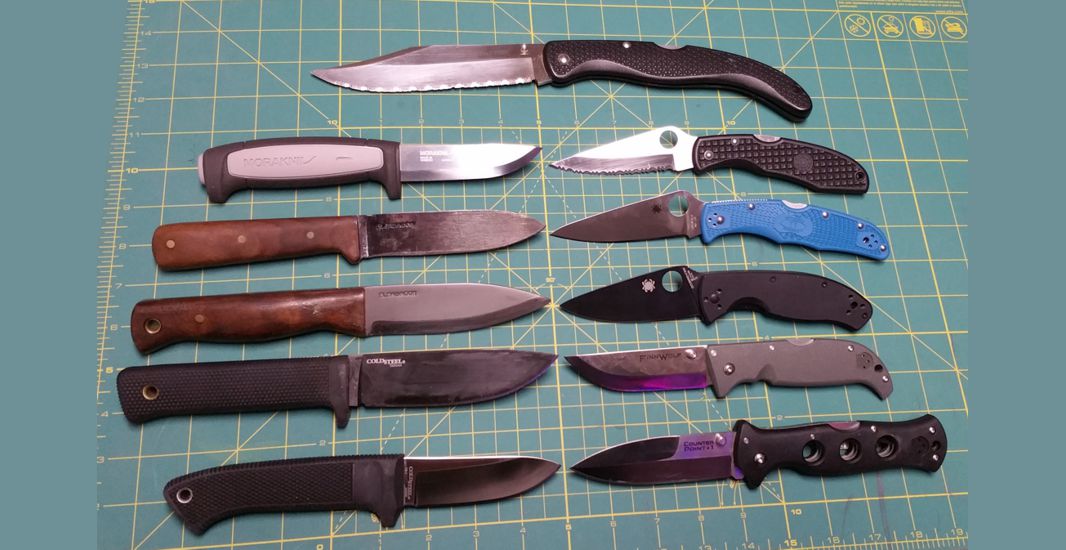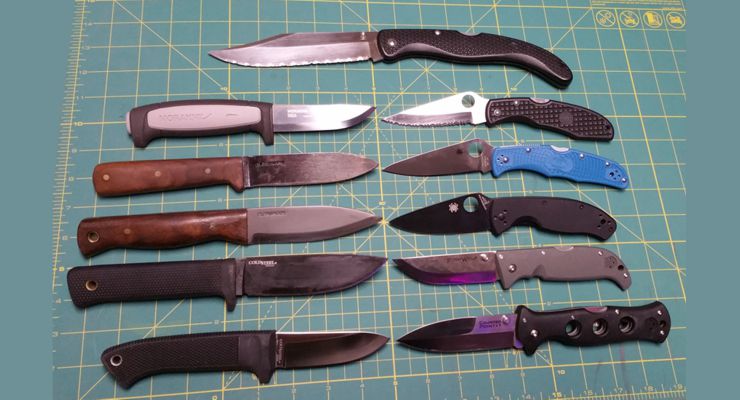 I was asked recently for my recommendation for Every Day Carry Knives (a.k.a. EDC). The parameters were that this knife should be capable for self defense use as well as legal in the majority of states in the U.S.
I was asked recently for my recommendation for Every Day Carry Knives (a.k.a. EDC). The parameters were that this knife should be capable for self defense use as well as legal in the majority of states in the U.S.
Unfortunately laws on the subject vary from state to state (and often between areas within the same state), so blanket rules on legality are hard to put together. Since its such a difficult question to answer across so many jurisdictions, maybe a better way to look at this is to give you a set of questions to think about while you research the best options for your area.
Let’s start with a list of priorities.
Your EDC knife should be:
1. Legal in your area.
2. Practical for use in the 99% of the time you will not be using it for self defense.
3. Have features that will help in a self defense situation, while not making the knife look like a “fighting knife,” (which can cause their own share of problems, even if the knife is legal for you to carry).
Priority 1. “Is it legal for me to carry in my area?”
(Note: I am not a lawyer and you should not consider the following as legal advice. You should think of this as a guide to possibly help you ask the right questions when you do speak to a lawyer on these issues).
I grew up in New York City, where the local municipal code held that no civilian could carry a knife on his person when out in public that had a blade over 4 inches in length. Remember, this prohibition comes from NYC’s own code, not state law. Part of the New York state law on the subject of prohibited knives reads:
“The possession by any person of any dagger, dirk, stiletto, dangerous knife or any other weapon, instrument, appliance or substance designed, made or adapted for use primarily as a weapon, is presumptive evidence of intent to use the same unlawfully against another.”
Please notice that there is no mention of a prohibited blade length in NY state law. When I moved with my family to a rural area of New York state, I wanted to find a EDC knife that my wife could legally carry.
While reading state law on the subject, I thought that the phrase “dangerous knife” was a bit vague. So I brought several knives from my collection to show one of the county court judges I work with and asked him to tell me which were legal for civilians to carry in our area. He said there were two factors at play. One was state law and the other was the history of the interpretation of that law by the judges of our state. When I asked him about that vague phrase “dangerous knife” he said that the courts have held that a knife whose primary purpose is for outdoor sports, cooking, or working in various professions that require a cutting tool, would all be fine. But a knife that was intended as a “fighting knife” or “military knife” was considered a “dangerous knife” even if it didn’t fit into the other categories of prohibited knives, such as daggers or switchblades.
I had a large camp knife with a nine inch blade on the table before the judge, which he said was legal for for civilians to carry under state law, (though you might get some strange looks if not dressed for hunting, fishing, camping, etc). Next to this was a small karambit with a three inch blade, which the judge said my wife should not carry because “it looks like a fighting knife.”
Another fly in the ointment is the prosecutorial discretion of your local District Attorney’s Office. In my part of New York state, (a rural county two hours north of NYC) it is common to see men out in public with a folding knife clipped in their pocket and no one bats an eye at this. However, in NYC the clip of a folding knife peeking out of a pocket is considered probable cause for a police officer to ask to examine your knife. If he can manage to open your knife with one hand, you will likely either be arrested for possession of a “gravity knife,” or at least ticketed for the possession of a prohibited knife and have your knife confiscated: even if the knife has a blade less than 4” in length. This interpretation of what constitutes a gravity knife (overly broad in the opinion of many knife experts) was started by left-wing District Attorney for Manhattan Cyrus Vance Jr. and spread to the rest of New York City’s boroughs. In most other areas of New York state, the local D.A.’s office understands the difference between a true switchblade and a knife with a thumb stud or opening hole.
Keep in mind that things may have gotten even worse now in NYC, as my info is a few years old. Therefore, it is your responsibility to do your own research with local law enforcement sources before carrying a knife in an area that’s unfamiliar to you, before you go there.
Another issue to keep in mind is that, in many states and local municipalities, there is a difference between what you can legally carry in plain view and what you can carry concealed. Texas is a good example in this regard. As of September 1, 2017, Texas now allows the “open carry” (in plain view) of any size blade. However, if you carry a concealed knife, then the old state restriction of 5 1/2 inches applies to blade length.
In addition, where you carry makes a difference in many jurisdictions. Bars, state and federal buildings, schools and courthouses may have different rules in your area. In some areas, you can safely exchange your knife for a receipt from a security officer when you enter a building and have the knife returned to you when you leave. In others, you are in violation of the law merely by the act of entering the building with a knife.
For more on the subject of state knife laws, visit the American Knife and Tool Institute website, which has a useful page on the subject of state knife laws.
American Knife and Tool Institute
For a general look at the law and self-defense, read my post on the subject;
Issues Regarding Self-Defense and The Law
However, I have to warn you that you can’t just look up your state’s law on carrying a knife and think you are finished with the issue. You really have to talk to either a criminal defense lawyer in your area, or members of local law enforcement (preferably both and more than one of each) and try to get a consensus on day to day enforcement and interpretation of the law specific to your area.
Note: An issue for civilian CCW holders with knives to consider:
In many jurisdictions around the US, handing your carry permit to a law enforcement officer signals to him that you are one of the “good guys” and he probably won’t look too carefully at any knife you have on you, (especially after reading news reports of civilian CCW permit holders saving cops lives, as we’ve seen in the last few years).
In other jurisdictions however, cops are encouraged by their departments to deal with civilian CCW permit holders with suspicion and will hold you to the absolute letter of law regarding any and all weapons on your person; including that pocket knife you have that’s “just a hair” over the states legal limit on length, or carried for a “non sporting or work related purpose” such as self-defense.
The bottom line is that you have to know the laws in your area, the ways these laws are applied on the street by local LEOs, as well as the ways they are interpreted by your local District Attorney’s office and Judges.
Priority 2. “Is it practical for daily use?”
The knives I choose for daily carry are pretty straight forward in design.
I usually have two knives on my person in addition to those on my multitool.
One knife is for wilderness woodcraft use, with a carbon steel, non-serrated blade and the other with a stainless steel, serrated blade useful for cutting fibrous materials such as car seat belts or clothing to examine a wound. I also try to keep my stainless blade clean for food prep. The stainless knife I choose is usually a folder, since this steel can survive riding inside my pants pocket better than carbon steel. Most of my sheath knives however, are made of tool steel (a.k.a. carbon steel).
Note: all steel used in knives must have at least .5 percent of carbon in it, or the knife will not harden. Stainless steels contain at least 14% chromium in the mix, while tool steels have less than this percentage of chromium and are more susceptible to rust.
I have also carried two of the same model sheath knives on camping trips; one with a tool steel blade that stayed on my person and a stainless steel version of the same knife, that stayed in my pack for food prep (both were Mora Companions). I tend to think of these two knives as my “clean knife” (for food) and my “dirty knife” (for everything else).
What’s the practical difference between stainless and carbon/tool steels? Well, other than the obvious (stainless vs not stainless), you can usually get a good quality knife with a tool steel blade for a lower price than a stainless steel knife of the same quality. To put it another way, to get the same edge holding and strength as an inexpensive tool steel blade, but made in stainless steel, you usually have to spend a lot more and get a higher priced knife. The exception to this rule are Mora knives, where both the tool steel and stainless blades are inexpensive and well made. Those two sheath knives, one tool steel and one stainless, that I carried on camping trips were both Mora knives and cost less together than a single knife of similar quality from most other companies (each of these Mora Companion models currently lists for less than $15 on Amazon).
Since I carry my pistol on my right side, I carry my main EDC knife on my left , (usually a folder in my left side pants pocket while on duty and a sheath knife on my left hip when off). I recommend these methods of carry to all my students who carry a firearm on a daily basis; whether law enforcement officers (LEOs) or civilians with concealed carry weapon (CCW) permits. I tell them “the gun is there to protect you and the knife is there to protect the gun.”
In the weapon retention classes I teach, the hand that normally draws the firearm is tasked with keeping the gun in the holster during a gun disarm attempt, while the support hand is in charge of “convincing” the bad guy he should stop trying to take your firearm. Having a knife in your support hand makes the “convincing” part much easier to accomplish.
Note for LEOs: What then are the pros and cons of a sheath knife vs folder for LEO weapon retention? Under the stress of someone trying to disarm you of your firearm, an easy to grab and deploy sheath knife makes sense. However, what makes the sheath knife easy for you to grab also makes it easy for your opponent to grab as well. In my job, working 99% of the time indoors at court, often in close proximity to the public; it makes sense for me to limit my on duty knife to a folder. However, most of my LEO students are working outdoors, usually alone on the road and many carry some type of sheath knife on their support side. I’ve been seeing a move lately towards that support side knife choice being a push dagger, as the T-shaped handle hides better on a duty rig than a straight handled knife and is still easy to deploy under stress. If you go this route, you might consider wrapping the grip of a rubber handle with electrical tape. “Grippy” rubber handles on push daggers, like those on the popular Cold Steel models, have been known to rise up by rubbing on clothing and get pulled out of their plastic scabbards and fall to the ground at unfortunate times and places.
Priority 3. “Can it be used for self-defense without looking like a fighting knife?”
An issue to keep in mind here is one of “financial self-defense.” You can successfully defend yourself against a bad guy by using your knife, with a model that is perfectly legal within your state and local laws, have the incident declared justifiable self-defense by a grand jury and still get sued by the bad guy’s family in a civil law suit. Your odds of coming out of this with your income intact will be better the less your knife looks like a “fighting knife” and the more it is used as a typical work or sportsman’s knife in your area.
So, if we are restricting ourselves to practical daily-use knives that don’t scream “fighting knife” to judges and juries, what features can help our use in self-defense situations without causing other problems?
First, we should ask, “What is a fighting knife?” One of the defining features of a fighting knife in the minds of many people is a knife with a double guard (a.k.a. a cross guard). We see cross guards used on most medieval swords and many dedicated fighting knives, such as traditional bowies. Therefore, a cross guard or double guard on a knife to many people equals a fighting knife, (no matter if these guards are too small to provide much in the way of real protection against an opponent’s blade, such as is the case with the small guards on the Ka-bar fighting and utility knife used by the US military).
A single guard however is a common safety feature found on many kitchen and camping knives to keep your fingers from sliding down the blade and getting cut during common tasks.
In addition to a double guard, another feature we see in many dedicated fighting knives is a clip point with an easily sharpened false edge; as we see on many bowie knives and military knives. (A simple clip point with no false edge, as we see on many folders, doesn’t seem to have the same stigma attached to it, at least in the areas I travel in).
See the following definition of a Bowie knife:
Also visit the AKTI knife definitions page:
AKTI Approved Knife Definitions
And of course, a full double edged blade is a defining feature of a dagger, which most people would agree, is a dedicated fighting knife. These are illegal under most state laws, although some states (such as Texas) make a distinction between what it allows concealed and what is allowed when carried in plain sight (a.k.a. “open carry”). Therefore, you should check the laws and practices in your area to learn if there is a distinction between what is allowed “in plan sight” and what is allowed concealed.
When you look over my own EDC knives, you will find I prefer knives with some sort of mechanical stop to keep your fingers from sliding up on the blade. This can be a single guard, a notch or finger grove in the handle, or a thumb ramp on the spine of the blade. There are several uses for a knife that makes this feature a good idea, both for safety reasons and for more control when using the knife for delicate work, such as when cooking, camping or the processing of an animal when hunting.
MY EDC PICKS: Folders
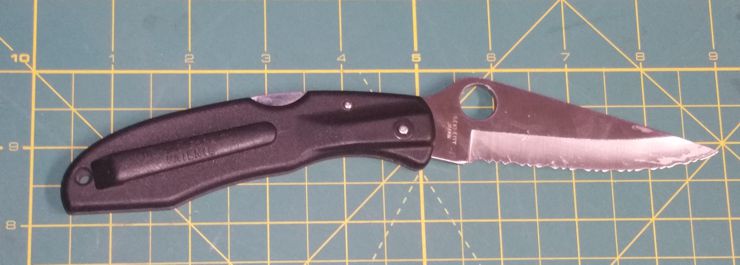
Spyderco Endura. The knife you see here was used by my wife to save herself from an abduction and assault by two men in a Home Depot parking lot on a Saturday afternoon in August of 1993. When they tried to grab her, she was able to quickly draw and open the knife due to the pocket clip and thumb hole. She then yelled “Get back or I will gut you right here” while displaying the knife. The sight of the knife and her attitude convinced them they had picked the wrong woman to attack and they ran back to their vehicle and drove away at full speed.
The knife she had back then was the old model Endura, with the plastic pocket clip. My wife now carries the new version (shown below) with the steel clip, as this is less likely to loosen up and fall from the pocket. Many an old Endura was lost due to the plastic clip opening, not when the owner was walking around, but when sitting or rising from a chair or car seat. We found my wife’s Endura on the ground below her car door twice before deciding it was time to retire this knife and go with the new model with the steel clip. I’ve heard from friends that the older versions of Cold Steel’s Voyager folders had a similar problem with their plastic clips.

Here is a new model Endura. The specifications below apply to this model.
Endura specs:
Overall Length: 8.75” (222 mm)
Blade Length: 3.75” (96 mm)
Steel: VG-10
Closed Length: 5” (127 mm)
Edge Length: 3.438” (88 mm)
Weight: 3.6 oz (103 g)
Blade Thickness: .125” (3 mm)
Handle: FRN (a type of plastic)
Clip Position: Ambidexntorus
Tip Carry Position: Tip-Up/Down
Lock Type: Back Lock
Grind: Saber
Origin: Japan

Spyderco Tenacious. This knife and the others in Spyderco’s value folder line are among my favorite EDC folders currently made. The other models in this line are the Ambitious (2.5” or 63.5mm blade), Persistence (2 3/4” or 69.85mm blade) and the Resilience (4 1/4” or 107.95mm blade).
Tenacious specs:
Overall Length: 7.76” (197mm)
Blade Length: 3.39” (86mm)
Steel: 8Cr13MoV
Closed Length: 4.45” (113mm)
Edge Length: 3.39” (86mm)
Weight: 4.1 oz (117 g)
Blade Thickness: .118” (3mm)
Handle: G-10
Clip Position: Ambi
Tip Carry Position: Tip-Up/Down
Lock Type: LinerLock
Grind: Full-Flat
Origin: China
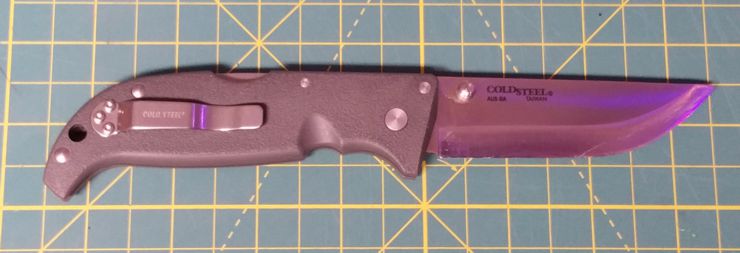
Cold Steel Finn Wolf. I picked this up for my son as a good, basic EDC folder, but he preferred the opening hole of the Spyderco models. If you prefer a thumb stud opener with a 3.5” blade, then this may be a good choice for you.
Specs:
Blade Length: 3-1/2” (88.9 mm)
Blade Thickness: 3 mm
Overall Length: 7-7/8” (200.025 mm)
Steel: Japanese AUS 8A Stainless
Weight: 3.4 oz. (121.9 g)
Handle: 4-3/8″ (111.125mm) OD Green Griv-Ex
Pocket Clip: Ambidextrous Pocket / Belt Clip
Made in Taiwan

Cold Steel Counterpoint 1. I often recommend this knife to my LEO and CCW students who want a mid-sized folder that’s practical for self defense use. I like this folder because of the symmetry of its blade and handle. This allows for its use in a wide variety of grips. When closed, the knife can be used as a less-lethal palmstick tool. When opened, it is one of the few folders that is comfortable to hold in icepick grip with the edge facing inward for weapon retention techniques.
The potential downside of this design it that it may look like a dedicated “fighting knife” to some people, but the blade does share the same outline as one of the top bushcraft/camping knives, the Condor Kephart model (see the sheath knife section below). Still the appearance of this knife is something to consider if you choose it as an EDC knife.
Specs:
Weight: 4.7 oz. (133.24 g)
Blade Thickness: 3.5 mm
Blade Length: 4” (101.6 mm)
Handle: 5″ (127mm) Griv-Ex
Overall: 9” (228.6mm)
Steel: Carpenters CTS BD1 Alloy w/ Satin Finish
Pocket Clip: Ambidextrous Stainless Pocket / Belt Clip
Made in Taiwan
MY EDC SHEATH KNIVES
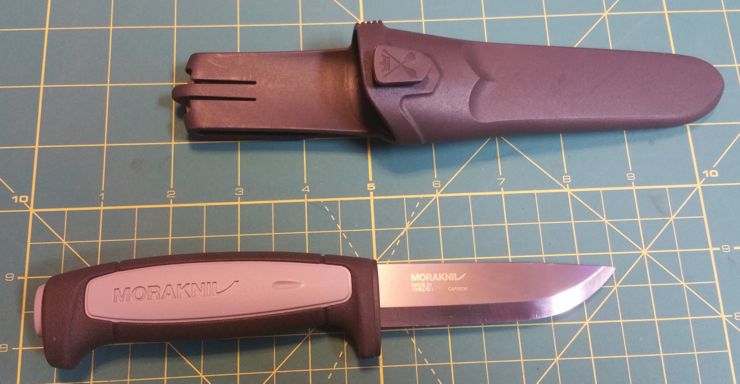
Mora Robust
It’s hard to find a knife company that gives you more bang for your buck than Mora of Sweden. The short and stout Mora Robust model gives you a tool steel blade just 3-5/8” inches long, an eighth of an inch thick, and a handle long enough for large hands to grasp comfortably, (in my experience, this pairing of short blade and decently sized handle is rare in sheath knives).
One thing that keeps the price so low on the Moras is their plastic sheaths. While adequate for belt carry in the woods, you will find a lot of people who EDC these knives will purchase or make a kydex sheath* for their Moras.
Specs:
Blade Length: 3-5/8” (92.075mm)
Handle Length: 4-1/2” (114.3mm)
Overall Length: 8-1/4” (209.55mm)
Blade Thickness: 0.128” (that’s just a hair over 1/8” or 92.075 in millimeters)
Blade Shape: Clip Point
Blade Grind: Scandi
Blade Finish: Satin
Blade Material: Carbon Steel
Handle Thickness: 0.855” (or 21.717 in millimeters). Please don’t ask me how Mora of Sweden came up with these dimensions. I haven’t a clue
Handle Material: TPE Rubber, Gray and Black
Sheath: Plastic
Weight: 3.6 oz. (102 g)
Made in Sweden
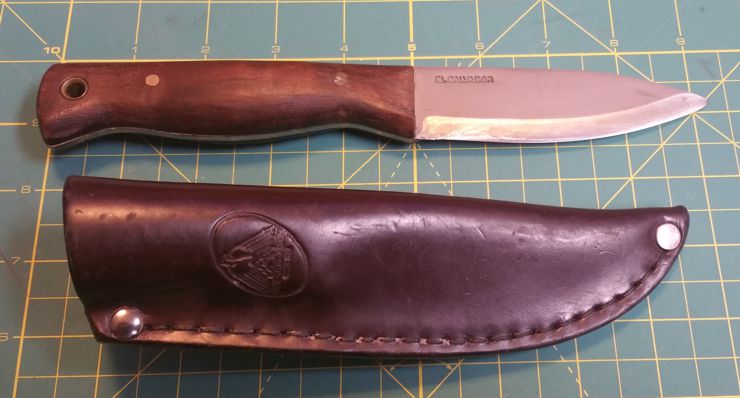
Condor Kephart Survival Knife
Horace Kephart was a woodman and outdoors writer in the late 19th and early 20th centuries whose books on wilderness living became classics in the field. Here is Kephart’s description of his knife from his 1906 book Camping and Woodcraft:
“Its blade and handle are each 4-1/4 inches long, the blade being 1 inch wide, 1/8 inch thick on the back, broad pointed, and continued through the handle as a hasp and riveted to it. It is tempered hard enough to cut green hardwood sticks, but soft enough so that when it strikes a knot or bone it will, if anything, turn rather than nick; then a whetstone soon puts it in order.”
“The handle of this knife is of oval cross-section, long enough to give a good grip for the whole hand, and with no sharp edges to blister one’s hand. It has a 1/4 inch knob behind the cutting edge as a guard, but there is no guard on the back, for it would be useless and in the way. The handle is of light but hard wood, 3/4 inch thick at the butt and tapering to 1/2 inch forward, so as to enter the sheath easily and grip it tightly. If it were heavy it would make the knife drop out when I stooped over.”
“This knife weighs only 4 ounces. It was made by a country blacksmith, and is one of the homeliest things I ever saw; but it has outlived in my affections the score of other knives that I have used in competition with it, and has done more work than all of them put together.”
The model from Condor Knife and Tool adds a much better sheath than the original, being made of a thicker leather. The brown leather sheaths from Condor are probably the best leather sheaths you will find on a factory made knife, (Condor seems to use thinner leather for their black sheaths, which I don’t like as much).
I’ve learned to add a dip in hot, melted beeswax to all my Condor leather sheaths and now my knives stay in place with a security usually reserved for custom made kydex sheaths, while still being able to be removed smoothly. I’ve duct taped a ferro rod and a few other small survival items on the back of my Kephart sheath as it’s my usual woods companion. The beeswax dip helps in this also, as duct tape will not stick well to the oiled leather as it comes from the Condor factory.
Specs:
Blade: 1075 High Carbon Steel
Blade Finish: Natural
Handle: Hardwood
Sheath: Handcrafted Welted Leather
Blade Length: 4-1/2” (114.3mm)
Thickness: 1/8” (3.175mm)
Overall Length: 9” (228.6mm)
Weight: 0.45 lbs. (0.204 g)
Made in El Salvador

Condor Bushlore
Another good bushcraft and camping knife from Condor. This was my woods knife before the Kephart. It is just as good a knife as the Kephart. I switched because the Kephart’s handle sticks a bit more out of the sheath, making it easier for my big mitts to draw. This sheath also received the hot beeswax treatment.
Specs:
Blade Length: 4-5/16” (109.5375mm)
Blade Thickness: 1/8” (3.175mm)
Overall Length: 9-5/16” (236.5375mm)
Blade Material: 1075 High Carbon Steel
Blade Finish: Blasted Satin
Handle: Hardwood
Sheath: Handcrafted Welted Leather
Weight: 0.77 lbs. (0.349 g)
Made in El Salvador
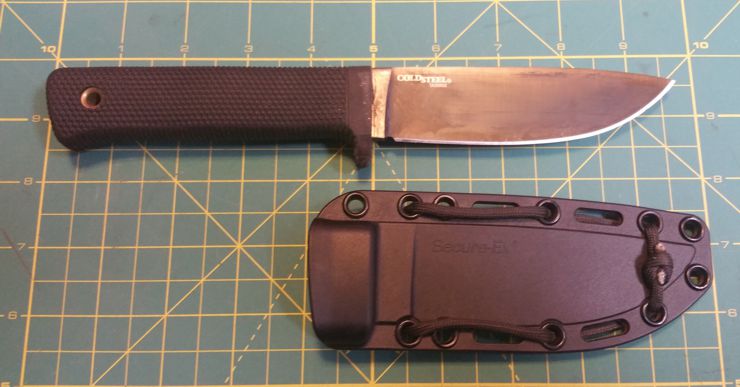
Cold Steel Master Hunter
I’ve owned the Carbon-V version of this knife for two decades. The Master Hunter makes a great hunting and general purpose camping knife. I recently purchased the new version with CPM-3V steel and Secure-Ex sheath for my son. You will see in the photo that I took the nylon belt loop off the sheath and replaced it with paracord, wrapped through the rivets. This allows the sheath to be mounted directly on the belt and has it ride higher on the hip. Here are some pros and cons to this style of carry to consider. The factory belt loop is intended to make the sheath ride low, out of the way of the large hip belt you find on full size back packs. These days my woods treks with my son are just day hikes with small day packs, so we don’t have to worry about knife sheaths bumping up against hip belts. However, we have had occasions of passing other hikers on the trail (probably up from NYC) who looked aghast at the sight of the knives on our hips. We therefore keep our blades on our belts, out of sight under a shirt, so as not to upset any visiting city snowflakes.
Specs:
Blade Length: 4.5” (114.3mm)
Handle: 4.75” (120.65mm) Kray-Ex
Overall: 9.25” (234.95mm)
Blade Thickness: 0.19” (11.176mm)
Blade Material: U.S. CPM-3V High Carbon Steel
Blade Finish: Stonewash
Sheath: Tek-Lok Compatible Secure-Ex Sheath
Item Name: Master Hunter CPM-3V
Weight: 6.4 oz. (181.4 g)
Made in Italy
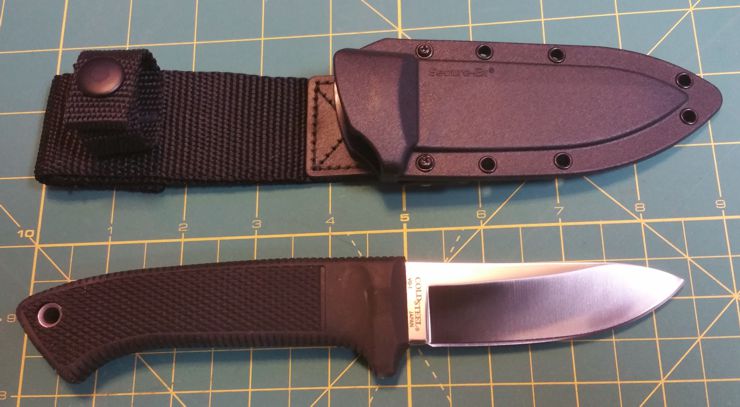
Cold Steel Pendleton Hunter
This is a nice little hunting knife for those who want a good quality, small sheath knife with a stainless steel blade. Especially if your area limits blades to 3.5” in length; which leaves out the much less expensive Mora Robust with its 3.625” blade. The stainless steel blade and rubber handle make a good combo on a knife intended for working on the insides of a deer you’ve just harvested. The Pendleton Hunter is another rare case of a quality sheath knife with a sub 4” blade with a handle that fits large hands. I intend on making a kydex sheath for it with a deeper pouch to hold the blade, since the minimalist factory sheath makes me worried about loosing it when on the trail.
Specs:
Blade Length: 3-1/2” (88.9mm)
Overall Length: 8-1/4” (209.55mm)
Steel: VG-1 Stainless
Weight: 5.8 oz (136 g)
Blade Thickness: 3/16” (4.7625mm)
Handle: 4-3/4″ (120.65mm) Kray-Ex
Sheath: Secure-Ex Sheath
Made in Japan
If you like the look of the Pendleton Hunter, but need a smaller blade to comply with local laws, Cold Steel offers a Pendleton Mini Hunter with a 3” (76.2mm) blade. Be warned though, this is a much smaller knife overall and most men will only be able to get three fingers on the grip. On the plus side, the Mini is light enough to make a good neck knife and sells for only $27 on Amazon as I write this.
*Note on Kydex sheaths: If you want to make your own Kydex sheath, first go to YouTube and watch some Kydex sheath making tutorials. I’ve made a few for my knives and it’s really very simple to do. If you want to try the process out with one knife, but don’t want to buys supplies for multiple sheaths, Armory Plastics sells DIY Kydex sheath kits on Amazon for about $20.
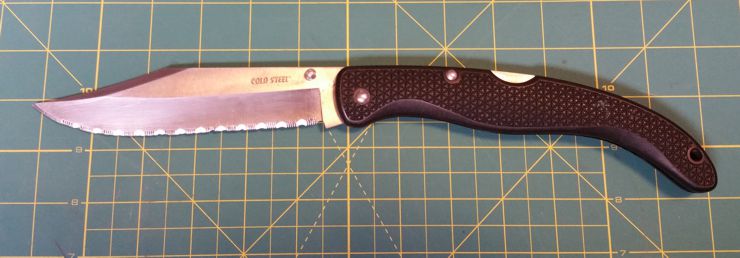
My final knife is the 2XL Cold Steel Voyager. With a 6” (152.4mm) blade of VG-1 steel, it is probably a bit large for civilian carry in most parts of the US, but I thought you’d like to see all of my EDC choices. For many years this was my on-duty EDC knife. Cold Steel stopped making this size a few years ago, The 5.5” (139.7mm) is currently their largest model. I retired my old 2 XL Voyager from duty carry when CS ended this model. These days it usually rides in my pocket on day hikes and fishing trips, where it is a champ at taking overgrown vines and thorn branches out of my path with the ease of a much larger blade and then disappearing back into my pocket.
EDC Women’s Self Defense Knives


